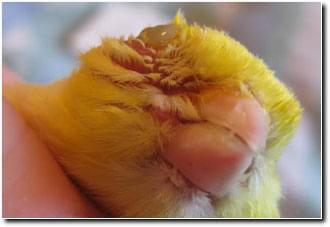
Canary Pox - Causes, Prevention, Symptoms, Treatment
and Supportive Nutrition
Articles and Information - Lady Gouldian Finch
Canary Pox is a serious disease of canaries that is transmitted from bird to bird by mosquitoes, mites, other biting insects and through contact with bite wounds. Canaries are not the only birds affected by the pox. Any bird in the Serin family, which includes grey singers, green singers, and European goldfinches, is prone to this virus. Wild birds, especially sparrows, may infect canaries with other forms of pox.
 Canary Pox - Article and Information
Canary Pox - Article and Information
Several forms of canary pox may appear simultaneously. The skin or dry form may first present as conjunctivitis and blinking. This form produces crusty or ulcerated sores on the non-feathered parts of the body ( eyelids, head, face, beak, mouth and feet.) These early symptoms progress quickly to yellow-to-brown wart-like sores on the non feathered parts of the body.
Wet or diptheric form is more serious and creates sores in the mouth, throat, esophagus and upper respiratory tract producing coryza-like symptoms. The respiratory form or wet form, presents with a sudden onset of ruffled feathers, breathing difficulties, cyanosis (blue tongue) and death. Birds infected with this form are less likely to recover as the sores interfere with eating, drinking and breathing. With this form of canary pox, death rates may reach 100% within three days.
 Canary Pox - Lady Gouldian Finch Supplies USA
Canary Pox - Lady Gouldian Finch Supplies USA
Symptoms of Canary Pox
- Infection spreads very quickly.
- Scabs and pox sores form, especially on the eyelids, beak, feet and toes.
- Open mouth due to diptheric sores in the mouth and larynx
- Birds of all ages affected
- Death rate can be very high (20%-100%)
Treatment
- Identify and isolate all birds with Pox sores. Pox sores will enlarge for 2 weeks then gradually with treatment regress over the following 4 weeks.
- Use Pox Dry on a cotton bud each day to dry and clean pox sores. Gently clean the surfaces of the skin and mouth sores with the cotton bud but be gentle to avoid bleeding. The scab will fall away within a few weeks time.
- Dose severely infected birds with Enrofloxin (Baytril) antibiotic for 5 days
- Clean the cage of all feathers and dust as these are a common source of wet pox infections. Then disinfect the cage each week for four weeks with Pet Focus.
- Apply Orisept to dry up infected eyelid sores. Cull birds with serious eye and beak abscesses.
- "In Contact" birds should be moved inside to mosquito proof cages in small groups.
Prevention
Vaccination for protection from mosquito and wild birds is available. Vaccination should be administered one month before the onset of the mosquito season and repeated annually. Canaries will develop immunity three to six months following vaccination. Check with your Avian Veterinarian for more information.
Legal Disclaimer..
Terri's Glamorous Gouldians is not licensed to provide veterinary services. Nothing contained in the site is intended to replace the services of a licensed, trained physician or health professional or to be a substitute for medical advice of a veterinarian or trained veterinary professional
© lady gouldian finch.com 2017